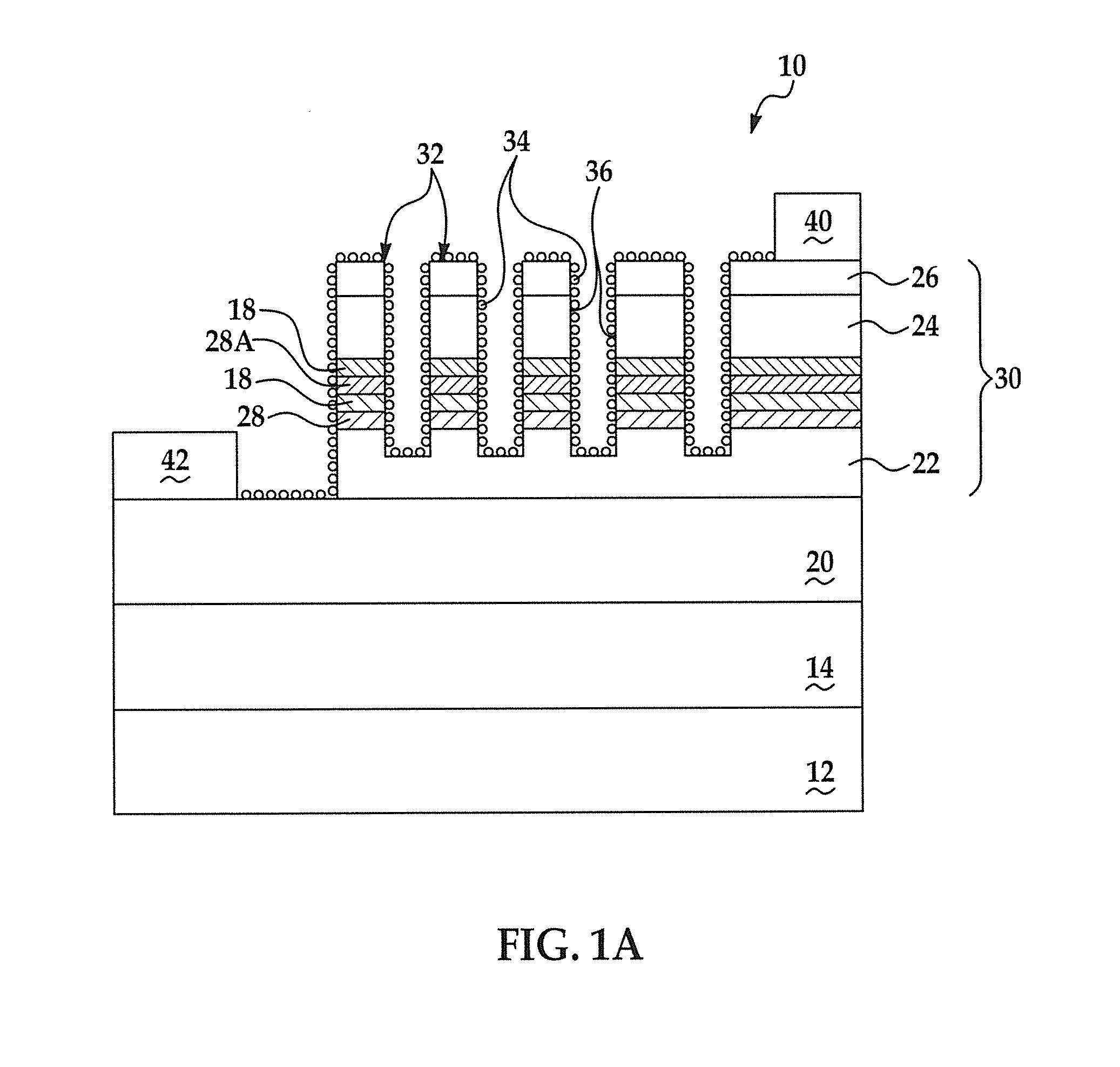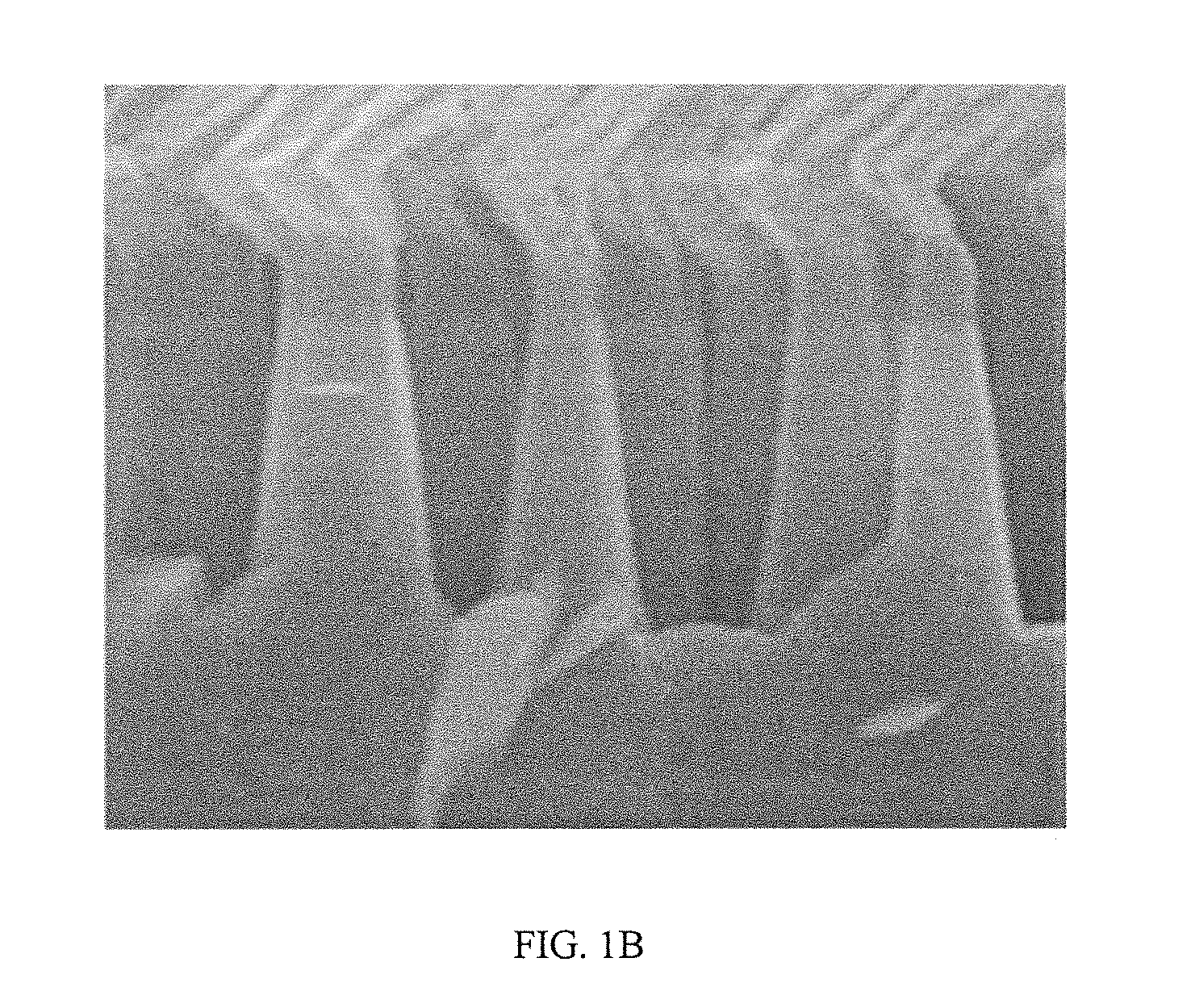Application of semiconductor quantum dot phosphors in nanopillar light emitting diodes
a technology of light-emitting diodes and quantum dots, applied in the field of light-emitting diodes, can solve the problems of difficult mixing and depositing uniform multi-phosphor films, difficult control of granule size, and number of performance limits of white leds, etc., and achieves efficient non-radiative transfer and improved efficiency
- Summary
- Abstract
- Description
- Claims
- Application Information
AI Technical Summary
Benefits of technology
Problems solved by technology
Method used
Image
Examples
example 1
Fabrication of InGaN / GaN Based Nanopillar LEDs
[0028]High density InGaN / GaN based nanopillar LEDs were fabricated by using self-assembled tin oxide (TO) nanodots and dry etching the InGaN / GaN using the TO nanodots as a mask. The self-assembled TO nanodots were produced as follows. A SiO2 layer was deposited on the top surface of the LED wafer using a plasma-enhanced chemical vapor deposition (PECVD) system, and then an indium tin oxide (ITO) layer was deposited onto the SiO2 layer using an electron beam evaporator. The sample with the LED wafer / SiO2 / ITO layers was dipped into a solution containing HCl to etch away indium oxide clusters, which gave rise to self-assembled tin oxide clusters on the SiO2 layer. The SiO2 layer was then etched using the tin oxide clusters as an etching mask. After the patterning of the SiO2 layer, the etching mask of the oxide clusters was removed using a chemical solution. Then, the LED wafer was dry-etched using the SiO2 clusters as an etch mask. Finally...
example 2
Fabrication of QD Coated Nanopillar LEDs
[0029]The InGaN / GaN MQW LED nanopillars were fabricated by the inductively coupled plasma (ICP) etching using self-assembled TO nanodots as the etching mask with the PL peak centered at 460 nm. By controlling the size of the TO nanodots and the ICP etching time, nanorods with a height of 500 nm and diameters ranging between 100 nm and 500 nm were fabricated successfully. A layer of CdSe / CdS core / shell QDs with the PL peak centered at 620 nm were coated over the nanopillar LED sample and subsequently annealed at 100° C. to remove the solvent. (The coating methods include soaking the nanopillar LED into the QD solution, spin-casting, drop-casting or mist deposition.) FIG. 1B is a cross sectional scanning electron microscopy image of the device so formed. FIG. 2A shows a field emission scanning electron microscopy (FESEM) image of a QD-coated nanopillar LED sample. FIG. 2B shows the z-scan 3D confocal fluorescent microscope image of the QD phosph...
example 3
Characterization of QD Coated Nanopillar LEDs
[0030]To study the direct MWQ to QD nonradiative energy transfer rate, time-resolved photoluminescence (TRPL) studies were performed for the InGaN nanorod LED structure of Example 1 with and without colloidal QD coating per Example 2. Two identical nanopillar LED samples with ˜200 nm nanopillar diameter were used for the measurement. Both samples coated with and without QD phosphors were excited by the second harmonic (λ=400 nm) of a femtosecond light source (Libra, Coherent Inc., 70 fs pulse duration, 1 kHz repetition rate, 1 mJ pulse energy at λ=800 nm). The photoluminescence (PL) signal from the MQW region of the nanorods was collected by a photomultiplier by passing through a band pass filter (460 / 10 nm). The time resolution of the whole system was about 10 ps. All measurements were performed at room temperature.
[0031]FIG. 3 shows the PL spectra of the two investigated nanorod LED samples coated with and without QD phosphors. The rela...
PUM
| Property | Measurement | Unit |
|---|---|---|
| height | aaaaa | aaaaa |
| height | aaaaa | aaaaa |
| quantum efficiency | aaaaa | aaaaa |
Abstract
Description
Claims
Application Information
 Login to View More
Login to View More - R&D
- Intellectual Property
- Life Sciences
- Materials
- Tech Scout
- Unparalleled Data Quality
- Higher Quality Content
- 60% Fewer Hallucinations
Browse by: Latest US Patents, China's latest patents, Technical Efficacy Thesaurus, Application Domain, Technology Topic, Popular Technical Reports.
© 2025 PatSnap. All rights reserved.Legal|Privacy policy|Modern Slavery Act Transparency Statement|Sitemap|About US| Contact US: help@patsnap.com



